The Mike Toole Show
Alternate History Makers
by Mike Toole,
For the past couple of anime seasons, everything's been coming up “isekai,” with a plethora of stories about regular people crossing over into bizarre fantasy worlds. We've had kids causing trouble with their smartphones, dimension-hopping family restaurants, and historical figures teaming up to fight Orcs and shit, just to name a few.
But in general, I like my isekai a little more grounded. I talked recently of watching Wings of Rean, Yoshiyuki Tomino's daffy Aura Battler Dunbine spinoff, and as nakedly weird and incoherent as the whole affair was, it still had some interesting ingredients to it—the central storyline involves a lost kamikaze pilot hopping out of a wormhole to angrily re-litigate World War II, just as a coalition of NATO officers seizes a new aircraft carrier, with the intent to declare statehood and freeze the global military-industrial complex in its tracks. That whole scenario made me think of The Silent Service, which made me think of The Final Countdown, which made me think of Zipang, which made me think of one big forerunner to the whole “isekai” concept—“rekishi kaihen”, tales of altered world history!

Stories of history indelibly altered by time travel or parallel world phenomena are nothing new. Great American satirist and anime character Mark Twain wrote a famous, funny story of a clever, meddlesome machinist from Connecticut who goes back in time and wreaks havoc in King Arthur's court, and western SF is littered with the idea of altered history, from The Man in the High Castle to The Coming of the Quantum Cats. In Japan, one of the first modern tales of altered history to get real traction was Ryo Hanamura's Sengoku SDF – the story of a Japanese Self-Defense Force unit catapaulted back in time to the Warring States period. It turns out Oda Nobunaga wasn't the only time-traveling alien wizard back in those days.
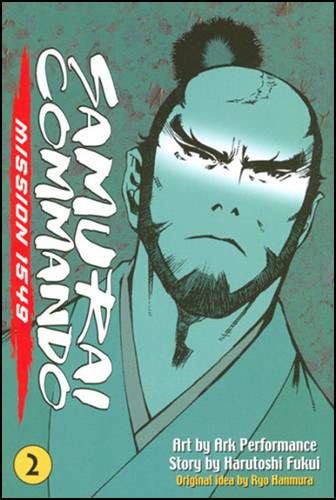
But Hanamura, who'd recently won the Seiun award, placed a wicked twist in his tale—rather than dominating the battlefield with their chopper, patrol boat, and tank, the SDF unit quickly finds themselves running out of resources to operate their vehicles. And rather than fleeing in terror in the face of this mysterious advanced technology, storied battlefield general Takeda Shingen analyzes his foes and shrewdly uses his guns and cavalry, routing them at every turn. This intriguing novel later got turned into a pretty good Sonny Chiba movie, which is known in the west as “GI Samurai,” almost as rad a title as Sengoku SDF. The late, great CMX localized the manga version of a 2005 film remake, entitled Samurai Commando. The time-traveling protagonists lose out in that version, too.
Anime's ultimate reikishi kaihen tale is almost certainly Konpeki no Kantai, aka Deep Blue Fleet. This sprawling saga of how Japan won the war in the pacific and later teamed up with the US to defeat the Nazis focuses on Admiral Isoroku Yamamoto, who's catapulted back in time just prior to his real-life death in the skies above Bougainville Island. (These alternate-world stories almost always start with the characters about to die horribly, only then they're suddenly and mysteriously transported elsewhere. In that respect, Deep Blue Fleet is just like GANTZ!)
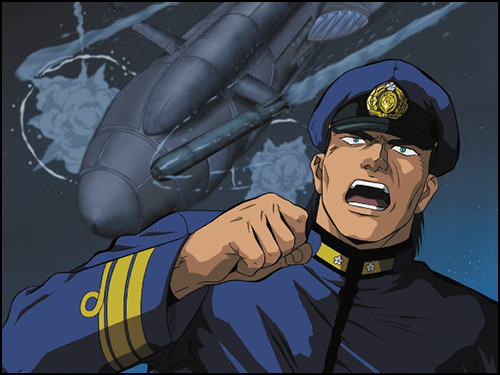
Yamamoto, finding himself back at the turn of the 20th century, elects to use his knowledge of the buildup and war in the Pacific to thwart the more militaristic General Tojo's ambitions and start developing newer, high-tech battleships and submarines from late in WWII (the series has an explanation for why Yamamoto remembers these prototype ship plans in such detail, but it's a little implausible), only decades early. Ah, now there's the Deep Blue Fleet of the title! Yamamoto, now using his original name Takano, uses his knowledge and influence to push hard against the US, liberating the old American colonies in exactly the way the real Japanese navy didn't liberate their colonies in actual history. The technology gap alone isn't enough to win the war, either—Takano first has to mount a more successful attack on Pearl Harbor than the historical one, and then plan strikes against the Panama Canal and the Manhattan Project. The proceedings are talky and a little silly, but as a history buff, there's still something weirdly charming about watching what is undeniably a long, complicated ploy by original novel author Yoshio Aramaki to reach the endpoint of having a noble, canny, vigorous Yamamoto engage the German Kriegsmarine in a wild Indian Ocean submarine war in the late 40s. The fact that he gets there by portraying the Allied nations as craven and self-interested is hardly surprising.
Deep Blue Fleet was a sustained hit in the 90s and 2000s, one of those rare long-running OVAs that bridged the gap between laserdisc and DVD releases. There seems to be little interest in a western release, which is a shame—the Blu-Ray boxes that came out a few years ago look pretty damn good. There's really only one issue I have with the series from a narrative standpoint, and that's the fact that pretty much every major divergence from world history is a product of Yamamoto's actions or ideas. The really great time-travel stories are ones that depict just how weird and chaotic the whole idea of time travel is—stuff like Primer and, well, The Time Machine. A guy named Kaiji Kawaguchi addressed this chaos with his own tale of World War II time travel in 2000, but before that, I want to talk a little about Kawaguchi, a giant of manga who's largely unknown in these parts.
Kaiji Kawaguchi grew up in the shadow of the post-war recovery—his dad crewed on a minesweeper boat during the war, settling down afterwards and having Kaiji and his twin brother Koji in 1948. The Kawaguchi brothers spent much of their childhood playing quietly together, immersed in a world of dad's war stories and detailed military model kits. Kaiji, the older of the twins, had a particular fascination with submarines and torpedoes, copying mechanical drawings from history textbooks and panels from Satoru Ozawa's Submarine 707 manga over and over again.
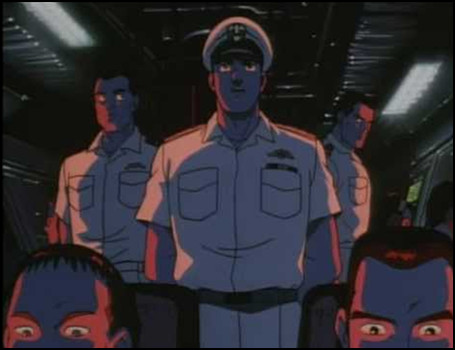
Despite this fascination, Kaiji Kawaguchi the manga artist built his fame in the 1970s by making detective stories and compelling, realistic manga about mahjong, which we'll never get to read because nobody plays mahjong in the west. Some of his works, like the private detective yarn Hard & Loose and the adult drama Love Stories, got adapted as anime, but they didn't get much traction. It took until 1988 for Kawaguchi to score his first truly long-running hit, the military and political thriller The Silent Service. That manga series, concerning the exploits of a smart, idealistic nuclear sub commander who engineers a defection, declares statehood, and boldly engages in both military maneuvers and diplomatic engagement against the US and Japan, ran for nearly a decade. The anime adaptation isn't too shabby, albeit the later episodes are so ritualistic and talky that US Manga Corps. passed on licensing them, after dubbing the first two episodes.
To get back to the whole rekishi kaihen business, let's talk about Kawaguchi's Zipang, and why Zipang is so good. Zipang is pretty strongly reminiscent of an American rekishi kaihen tale called The Final Countdown, in which a modern aircraft carrier is thrown back in time to World War II. In Zipang's case, it's not an American carrier, but a JSDF light battleship, cheekily named the JDS Mirai (“Future”), that goes back in time. It doesn't take too long for the ship's XO, Kadomatsu, to figure out what's happened, but the crew are faced with a grand, weird problem—their ship is powerful enough to alter the course of the war. Should they intervene on Japan's behalf, in the name of saving Japanese lives and possibly triggering a different outcome to the war at large, or should they stay out of the conflict, knowing full well that it was Japan's ruinous defeat that later led to the country's astonishing rebirth in the later 20th century?
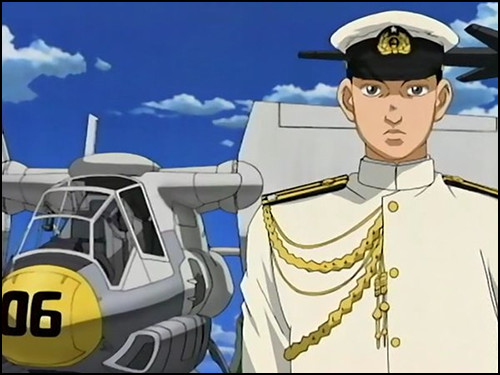
It's a smart, complex question, and Kawaguchi addresses it in a much more satisfying way that Deep Blue Fleet's “Yamamoto Does it All!” conceit—as soon as the Mirai makes its presence known, absolute goddamn chaos breaks out on both the Japanese and American sides. The mere sight of a bizarre, ultra-fast battleship causes Admiral Yamamoto to panic and order the Yamato itself to withdraw from forward operations. Changes to troop and ship maneuvers thanks to this mysterious ship leads to the Daqing Oil Field getting discovered a decade early, which in turn leads to revolt and conflict in Manchuria. The USS Wasp breaks off and tries to engage the Mirai, and Kadomatsu and his team reluctantly sink the famous, doomed aircraft carrier with just a single tomahawk missile, irrevocably altering the theatre of war months before the Wasp's historical sinking.
The reluctance to engage by the Mirai's crew gives Zipang's story a lot of character. In general, the Mirai's crew are smart, capable people who are really dedicated to the idea of Japanese neutrality and diplomacy—even the most nationalistic of the ship's personnel worry about somehow ruining Japan's future by interceding. But their fortunes shift when they pick up a Japanese naval intelligence officer named Kusaka—an officer who did not survive the real-life WWII. Kusaka is surprisingly perceptive—he'd believed Japan was doomed, and delights in the crew's stories of a rejuvenated Japan of the 21st century—but he can't get past the idea of using the Mirai to turn the tables and secure victory for Japan in the Pacific. The crew, desperate to get back to their timeline, start to get this idea that if they alter the timestream enough, the resulting paradox will shatter their reality and they'll get to go home. It's really compelling stuff, which is probably why it lasted for 43 volumes and got a really solid anime adaptation.
Unfortunately, this anime adaption surfaced at the height of the mid-2000s anime bubble, which means it's long out of print and not a lot of people got to see it. Exacerbating things is a famously weird dub, commissioned by Geneon and created in Singapore by localization firm Odex. Both Geneon and Bandai Entertainment used Odex dubs a few times, with the idea that it was cheaper, and hey, North American fans wouldn't really notice the difference! Yeah, we noticed the difference, alright.
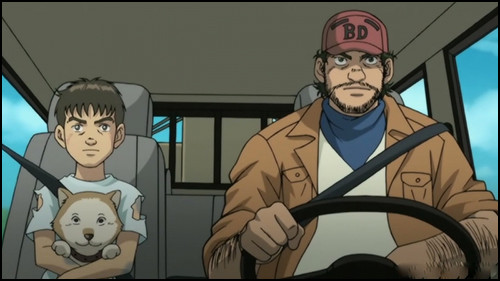
As for Kawaguchi, he wasn't done with the whole “altered history” thing after Zipang, either. Another mid-2000s work of his that got the anime treatment is Spirit of the Sun, a disaster story about a series of calamitous earthquakes that leaves Japan a nation of refugees. The country itself is literally split in half by the quakes, and sloppily governed with the help of both Americans in the south and Chinese in the north, which leads to political complications. Years later, Genichiro Ryu, who'd survived the initial disaster, is living in Taiwan. Still a refugee, he has to come to terms with his place and battle not just external factors, but his own disillusionment. Kawaguchi's story is a little cute, and tends to gloss over a lot of lingering cultural and territorial resentment between Japan and its neighbors, but I dig his idea of a younger generation of east-Asia residents, forced together by disaster, casting aside old prejudices and working to change their lives. The anime version, a two-episode OVA, is pretty solid work from Madhouse; it's the kind of thing I'm surprised we haven't seen released in the west yet.
In fact, aside from The Silent Service, the only Kaiji Kawaguchi work we've seen released in English is Eagle, his excellent political yarn about the US Presidential election, in which a young Democratic senator of mixed racial background battles both saber-rattling right-wing opposition and entrenched schemers in his own party, on the road to ultimately duking it out for the presidency. I'm not talking about Barack Obama, though, but rather Kenneth Yamaoka, Kawaguchi's Japanese-American senator from New York! Yep, Eagle is actually a parallel history story, one old enough to be long out of print. It's a story of the 2000 election in which Yamaoka slips past the presumed Dem candidate, vice-president, Al Noah, and courts the support of Bill and Ellery Clayton, on the way to a national campaign against Republican candidate Richard Grant.
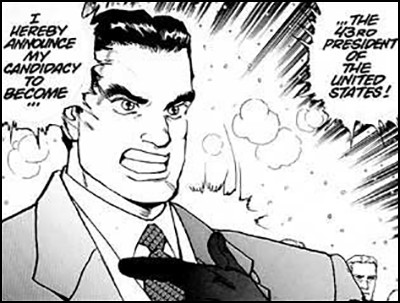
In retrospect, Kagawuchi's notion of a young, ethnically mixed candidate grabbing the nomination from an establishment pick seems weirdly prescient, even if it didn't come close to predicting the outcome of the 2000 election. But it's still a sharp, well-researched, and engrossing story, one that was good enough to bag multiple Eisner Award nominations. These kinds of political stories don't always age well, but Eagle is still remarkably instructive and topical.
Kawaguchi's a towering figure, but his most intriguing parallel-world tale might not even be about war. It's a collaboration with a manga creator named Tetsuo Fujii. See, twice every year Morning magazine has this thing called the Manga Open, a little submission contest where a panel of judges looks over story drafts and sample comics to develop new talent and maybe even discover a new series to run in the pages of one of their magazines. The most recent Manga Open winner to reach broad popularity just might be this little series called Space Brothers. Anyway, Fujii won the Manga Open grand prize with a unique idea: what if a Beatles cover band went back in time, to just before the real Beatles made their debut? Could they compete with the famous Fab Four? If they tried to steal their songs, could they also steal the spotlight? Kawaguchi, part of the judging panel, was so intrigued by this story—after all, he'd been a young man when the Beatles shot to international fame—that he asked Fujii if he could draw the characters himself. The resulting team-up gave us Boku Wa Beatles, which is usually translated as “We Are the Beatles.” That's not glib enough for me, though, so I just call it We're the Beatles.
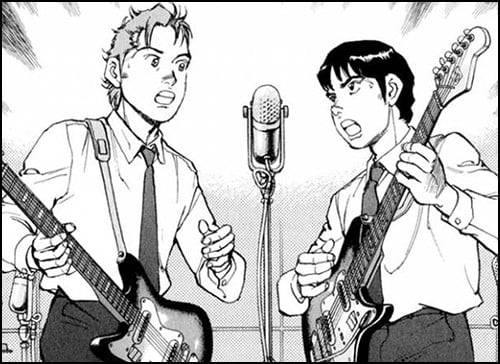
We're the Beatles really does take that part from Back to the Future where Michael J. Fox ludicrously invents rock n' roll via time paradox and spins it into a much grander tale of a couple of dudes from a Beatles tribute band in 2010. The band is doing good – they pack their small Roppongi venues with Beatles fanatics, they have a record deal, and they've just been invited to play a big anniversary festival in Liverpool. But the band is fragmenting—guitarist Rei isn't sure he wants to be a professional musician anymore, much less part of a stale old Beatles cover act. His bandmate Makoto gets in a fight over things, and they fall in front of a subway train, which fortunately mysteriously transports them back to 1961 instead of just running them over and killing them.
Rei and Makoto are dumbstruck by their new circumstances; the opportunity to “scoop” the real Beatles isn't immediately evident, because the pair look out of place, their slang is too modern, they can't use any of their currency (it's too new), and Tokyo is totally different. When they try to bring their Beatles sound to the public, they're met with some resistance at first—after all, the big sounds of the time were still late-50s American rock and Hawaiian music. Then, talent scouts realize that this intriguing new band, who dub themselves the Fab 4, have something nobody else does—a truly new sound!
The faux-Beatles get to work, but with reservations; Rei and Makoto have this vague idea that beating the Beatles to the starting line will push Lennon and McCartney to artistic heights wholly unknown in our world. The band's bass player, Sho, is mysteriously missing, and the notion of actually confronting the real Beatles looms in the background, like some sort of monster. Six months before the true Beatles make their debut in 1962, the Fab 4 release an LP in Japan-- one that starts with “I Want to Hold Your Hand” and ends with “Let it Be.” Fame beckons, and then the group is confronted with a mysterious voice on the phone who really wants to talk—a voice belonging to an English band manager named Brian Epstein.
I'd love to read this damn manga, but it's one of those titles that is probably impossible to export or adapt to anime due to licensing restrictions. Granted, the Beatles' music publishing folks are actually quite open to making deals for media like this, but it seems like it'd be hideously expensive. What I could see happening with We're the Beatles is a western movie or TV adaptation. Can you picture that?! Astonishing alternate worlds might be all the rage in anime and manga and light novels right now, but I remain a big fan of these tales of alternate pasts, ones that live right next door. I hope artists like Kaiji Kawaguchi keep opening these doors.
discuss this in the forum (12 posts) |